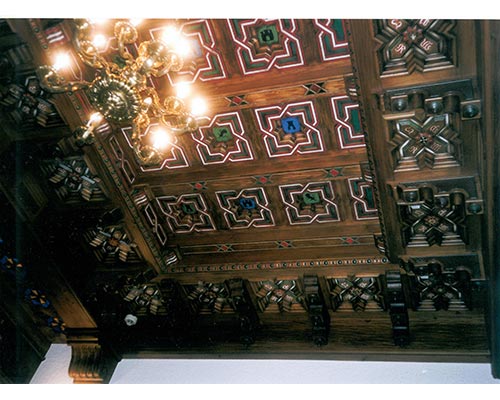One of the most complicated and satisfying challenges in wooden installations is the elaboration of Mudejar and neoclassic ceilings and its inclusion in such different architecture projects as homes, hotels, restaurants, hunting estates or wineries. Polichromed or not, in several relieves or plain wood, this is a familiar kind of work to us for History and tradition and it is probably the one that leaves you the highest satisfaction after finished.
Click on the picture to see more coffered ceilings by Ruarte Contract
That´s why we believe necessary to claim the weight of the Mudejar art and its coffered ceilings in the contemporary Spanish architecture, recalling where it comes from and where it is found the Mudejar footprint in Spain, specially focusing in some remarkable coffered ceilings in the World Heritage situated in Spain.
The Mudejar art was developed in the christian kingdoms of the iberian peninsula, adding materials, elements and influences of muslim-Spanish style, and it took place between 12th century and 16th century, as a consequence of the mix of christian artistic trends and (romanic, gothic and Renaissance styles) and muslim artistic trends of that time, to finally mean a lasting link between christian and muslim culture.
For some, epigone of the islamic art, and for others, period of the christian art in which it is born the islamic decoration in the peninsula, since it was practised by the Mudejars -people of muslim religion and arab culture who belonged to the christian kingdoms after the conquer of its land and they kept their religion and juridic status by paying taxes-, the Moorish -muslims turned into catholicism after the rule of the Catholic queen Isabel in 1502 to tell them to change their religion if they wanted to keep all of their rights- and christians who learned techniques from the arab art.
Click on the picture to see more coffered ceilings by Ruarte Contract
We could affirm that the Mudejar art is not a unitary style but a style with different characteristics depending on the region, so we can find Mudejar art and architecture from Toledo, Leon, Aragon and Andalusia. Finally, the Mudejar style also traveled to the Spanish colonies all over America, from Texas and California to Argentina. Finally, in the 19th century, it was born the neo-Mudejar style as a fruit of the revival architectonic fever of the time.
Curiously, it wasn´t until the 19th century when Amador de los Ríos first called this style “Mudejar art” in 1859 during his admission speech at the Academy of Fine Arts of San Fernando, discourse titled “The Mudejar style in architecture”.
Click on the picture to see more coffered ceilings by Ruarte Contract
We have afforded to select some of the Mudejar buildings and coffered ceilings more singular in the iberian peninsula, a selection of palaces, churches, towers, ceilings, doors, train stations, synagogues and mosques (as you are reading, yes, things of overlapping styles over time in the same buildings, maybe the birth of patchworks) coincidentally situated in Toledo. Or maybe not so coincidentally.
Mudejar coffered ceiling of the Synagogue of Samuel Levi or Transito (Toledo)
Mudejar facade and interior of the Mosque of Cristo de la Luz (Toledo)
Mudejar details in the Synagogue of Santa María la Blanca (Toledo)
Mudejar architecture in the Palace of Galiana (Toledo), where the legend tells that took place the love encounters of the French emperor Carlomagno and the beautiful Galiana, daughter of the muslim king Galafre
Mudejar coffered ceiling in the high cloister of the monastery of San Juan de los Reyes (Toledo)
Neomudejar wall, ceiling and facade of Toledo train station
 Mudejar tower of the church of Santo Tomé (Toledo)
Mudejar tower of the church of Santo Tomé (Toledo)












